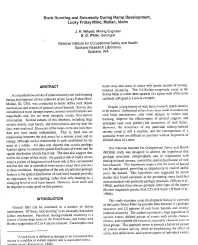Mining Publication: Rock Bursting and Seismicity During Ramp Development, Lucky Friday Mine, Mullan, Idaho
Original creation date: August 1998
A comprehensive survey of mine seismicity a rock bursting during development of two sublevels at the Lucky Friday Mine, Mullan, ID, was conducted to better define rock failure mechanisms and sources of ground control hazards. Survey data included rock burst damage reports, seismic event locations and magnitudes and, for the most energetic events, first- motion information. Several subsets of this database, including large seismic events, rock bursts, and microseismic activity near the face, were analyzed. Elements of the large-event and rock burst data sets were nearly independent. That is, there was no relationship between the risk posed by a seismic event and its energy, although such a relationship is well established for the mine as a whole. All data sets showed that certain geologic features appear to control the spatial distribution of events and the spatial distribution of rock burst risk. The data also suggest that, within the scope of this study, the greatest risk of injury occurs when a pocket of heightened rock burst risk is first encountered and that this risk is controlled when miners adapt their practices to these conditions. Recognition of the role of particular geologic features in the spatial distribution of rock burst hazards provides an opportunity for anticipating, rather than only reacting to, a changing level of rock burst hazard. However, much work will be required to make good on this promise.
Authors: JK Whyatt, BG White
Conference Paper - August 1998
NIOSHTIC2 Number: 20000184
In: Peng SS, ed. Proceedings of the 17th International Conference on Ground Control in Mining, 1998 Aug :317-325
See Also
- 60 Years of Rockbursting in the Coeur D'Alene District of Northern Idaho, USA: Lessons Learned and Remaining Issues
- Coal Mine Burst Prevention Controls
- Differential Wall Rock Movements Associated with Rock Bursts, Lucky Friday Mine, Coeur d'Alene Mining District, Idaho, USA
- Dynamic Failure in Deep Coal: Recent Trends and a Path Forward
- Improvements in Seismic Event Locations in a Deep Western U.S. Coal Mine Using Tomographic Velocity Models and an Evolutionary Search Algorithm
- Investigation of a Rock-Burst Site, Sunshine Mine, Kellogg, Idaho
- Mechanics of a Large, Strain-Type Rock Burst and Design for Prevention
- Proceedings: New Technology for Ground Control in Multiple-seam Mining
- The Role of Gas Desorption in the Energetic Failure of Coal
- Seismic Event Data Acquisition and Processing: Distribution and Coordination Across PC-Based Networks
- Page last reviewed: 9/21/2012
- Page last updated: 9/21/2012
- Content source: National Institute for Occupational Safety and Health, Mining Program


 ShareCompartir
ShareCompartir
